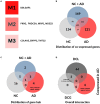The fusiform gyrus exhibits differential gene-gene co-expression in Alzheimer's disease
- PMID: 37255536
- PMCID: PMC10225579
- DOI: 10.3389/fnagi.2023.1138336
The fusiform gyrus exhibits differential gene-gene co-expression in Alzheimer's disease
Abstract
Alzheimer's Disease (AD) is an irreversible neurodegenerative disease clinically characterized by the presence of β-amyloid plaques and tau deposits in various regions of the brain. However, the underlying factors that contribute to the development of AD remain unclear. Recently, the fusiform gyrus has been identified as a critical brain region associated with mild cognitive impairment, which may increase the risk of AD development. In our study, we performed gene co-expression and differential co-expression network analyses, as well as gene-expression-based prediction, using RNA-seq transcriptome data from post-mortem fusiform gyrus tissue samples collected from both cognitively healthy individuals and those with AD. We accessed differential co-expression networks in large cohorts such as ROSMAP, MSBB, and Mayo, and conducted over-representation analyses of gene pathways and gene ontology. Our results comprise four exclusive gene hubs in co-expression modules of Alzheimer's Disease, including FNDC3A, MED23, NRIP1, and PKN2. Further, we identified three genes with differential co-expressed links, namely FAM153B, CYP2C8, and CKMT1B. The differential co-expressed network showed moderate predictive performance for AD, with an area under the curve ranging from 0.71 to 0.76 (+/- 0.07). The over-representation analysis identified enrichment for Toll-Like Receptors Cascades and signaling pathways, such as G protein events, PIP2 hydrolysis and EPH-Epherin mechanism, in the fusiform gyrus. In conclusion, our findings shed new light on the molecular pathophysiology of AD by identifying new genes and biological pathways involved, emphasizing the crucial role of gene regulatory networks in the fusiform gyrus.
Keywords: Alzheimer's disease; brain tissue; co-expression networks; differential co-expression networks; fusiform gyrus; hub genes; regulatory networks.
Copyright © 2023 Ribeiro-dos-Santos, de Brito and de Araújo.
Conflict of interest statement
The authors declare that the research was conducted in the absence of any commercial or financial relationships that could be construed as a potential conflict of interest.
Figures



Similar articles
-
Identification of deregulated lncRNAs in Alzheimer's disease: an integrated gene co-expression network analysis of hippocampus and fusiform gyrus RNA-seq datasets.Front Aging Neurosci. 2024 Jul 17;16:1437278. doi: 10.3389/fnagi.2024.1437278. eCollection 2024. Front Aging Neurosci. 2024. PMID: 39086756 Free PMC article.
-
Differentially expressed genes in Alzheimer's disease highlighting the roles of microglia genes including OLR1 and astrocyte gene CDK2AP1.Brain Behav Immun Health. 2021 Feb 24;13:100227. doi: 10.1016/j.bbih.2021.100227. eCollection 2021 May. Brain Behav Immun Health. 2021. PMID: 34589742 Free PMC article.
-
Correlation Between Brain Structure Atrophy and Plasma Amyloid-β and Phosphorylated Tau in Patients With Alzheimer's Disease and Amnestic Mild Cognitive Impairment Explored by Surface-Based Morphometry.Front Aging Neurosci. 2022 Apr 25;14:816043. doi: 10.3389/fnagi.2022.816043. eCollection 2022. Front Aging Neurosci. 2022. PMID: 35547625 Free PMC article.
-
Integrative network analysis of nineteen brain regions identifies molecular signatures and networks underlying selective regional vulnerability to Alzheimer's disease.Genome Med. 2016 Nov 1;8(1):104. doi: 10.1186/s13073-016-0355-3. Genome Med. 2016. PMID: 27799057 Free PMC article.
-
Alzheimer's disease.Subcell Biochem. 2012;65:329-52. doi: 10.1007/978-94-007-5416-4_14. Subcell Biochem. 2012. PMID: 23225010 Review.
Cited by
-
Dissecting the Puzzling Roles of FAM46C: A Multifaceted Pan-Cancer Tumour Suppressor with Increasing Clinical Relevance.Cancers (Basel). 2024 Apr 27;16(9):1706. doi: 10.3390/cancers16091706. Cancers (Basel). 2024. PMID: 38730656 Free PMC article. Review.
-
Identification of deregulated lncRNAs in Alzheimer's disease: an integrated gene co-expression network analysis of hippocampus and fusiform gyrus RNA-seq datasets.Front Aging Neurosci. 2024 Jul 17;16:1437278. doi: 10.3389/fnagi.2024.1437278. eCollection 2024. Front Aging Neurosci. 2024. PMID: 39086756 Free PMC article.
-
MED23 pathogenic variant: genomic-phenotypic analysis.J Med Life. 2024 May;17(5):500-507. doi: 10.25122/jml-2024-0065. J Med Life. 2024. PMID: 39144687 Free PMC article.
-
Voxel-wise insights into early Alzheimer's disease pathology progression: the association with APOE and memory decline.Geroscience. 2025 Aug;47(4):5825-5842. doi: 10.1007/s11357-025-01610-z. Epub 2025 Apr 1. Geroscience. 2025. PMID: 40167963 Free PMC article.
References
-
- Araújo G. S., Souza M. R. B., Oliveira J. R. M., Costa I. G. (2013). “Random forest and gene networks for association of snps to alzheimer's disease,” in Advances in Bioinformatics and Computational Biology, eds. J. C., Setubal, and N. F., Almeida (Cham: Springer International Publishing; ) 104–115. 10.1007/978-3-319-02624-4_10 - DOI
LinkOut - more resources
Full Text Sources
Miscellaneous

